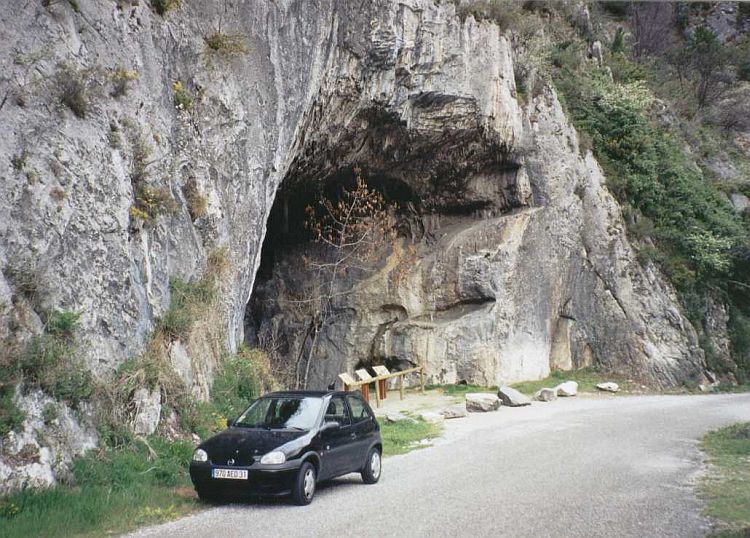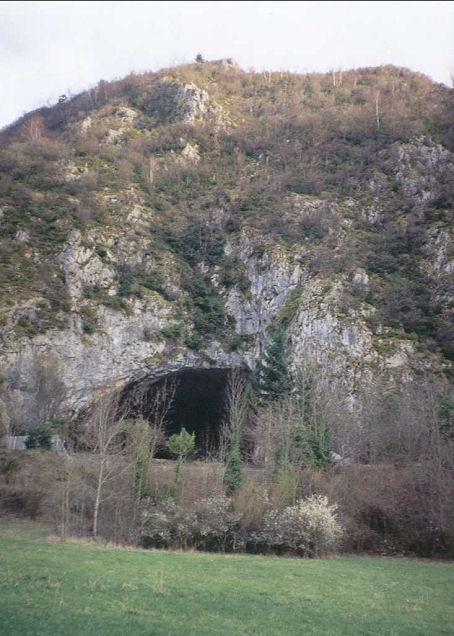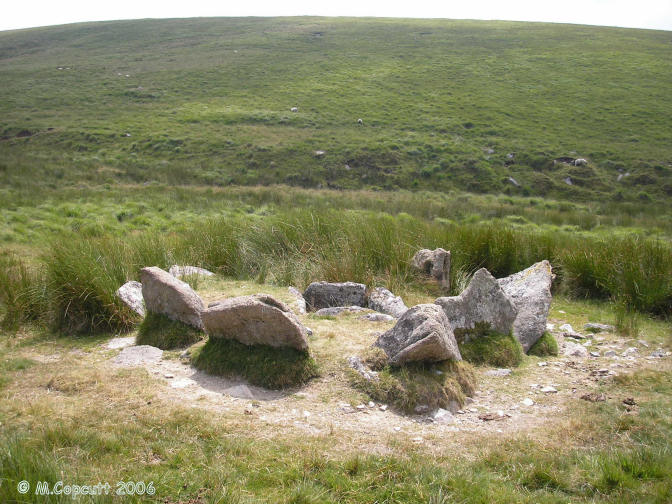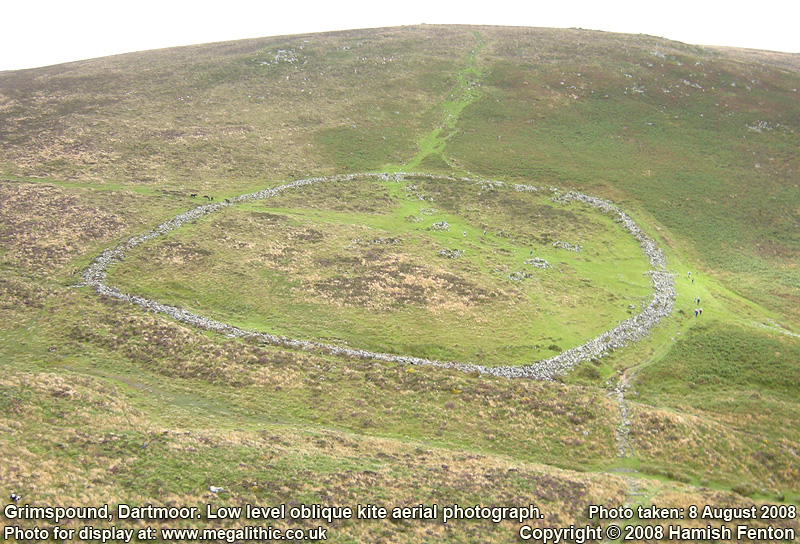Contributory members are able to log private notes and comments about each site
Sites theCAptain has logged. View this log as a table or view the most recent logs from everyone
Grotte de Mas D'Azil
Trip No.200 Entry No.1 Date Added: 15th Jun 2020
Site Type: Cave or Rock Shelter
Country: France (Midi:Ariège (09))
Visited: Yes on 27th Feb 2000. My rating: Access 5

Grotte de Mas D'Azil submitted by thecaptain on 13th Dec 2003. The southern, upstream, entrance to the magnificent cave at Mas D'Azil, Ariege, southwest France.
The river takes a shortcut through the hillside here, and has created a massive cave, which is so big that a fairly large road also runs through the cave.
Within this cave were found signs of life going back tens of thousands of years, and indeed the world famous Faon aux Oiseaux spear thrower. The finds here gave the name Azilian to an entire prehistoric culture.
(View photo, vote or add a comment)
Log Text: Drive south into the lower mountains from Toulouse. Visit St Sulpice, Mas D’Azil, many mountain roads, Foix, Pont du Diable.
Grotte de Mas D'Azil
Trip No.200 Entry No.25 Date Added: 18th Jun 2020
Site Type: Cave or Rock Shelter
Country: France (Midi:Ariège (09))
Visited: Yes on 24th Apr 2005. My rating: Access 5

Grotte de Mas D'Azil submitted by thecaptain on 13th Dec 2003. The southern, upstream, entrance to the magnificent cave at Mas D'Azil, Ariege, southwest France.
The river takes a shortcut through the hillside here, and has created a massive cave, which is so big that a fairly large road also runs through the cave.
Within this cave were found signs of life going back tens of thousands of years, and indeed the world famous Faon aux Oiseaux spear thrower. The finds here gave the name Azilian to an entire prehistoric culture.
(View photo, vote or add a comment)
Log Text: A lovely sunny day to explore the Ariege mountains. Puivert castle. Fontestorbes. Montsegur Castle. Pass de ? closed. Plain de ? Ax-les-Thermes, Col de Portel, scary roads. The usual drive through of Mas D’Azil on the way home to impress visitors. Get back to Toulouse late.
Grotte de Lombrives
Trip No.200 Entry No.13 Date Added: 15th Jun 2020
Site Type: Cave or Rock Shelter
Country: France (Midi:Ariège (09))
Visited: Saw from a distance on 2nd Apr 2000

Grotte de Lombrives submitted by durhamnature on 18th Nov 2012. Section of the cave at Lombrives, from "Anthropologie" via archive.org
Site in Midi:Ariège (09) France
(View photo, vote or add a comment)
Log Text: Drive S through Pyrénées mountains to Andorra. Lots of snow at top of pass. Look at Ax-les-Thermes, Niaux and other caves on way back, checking out the possibilities of a proper visit.
Grotte de Lombrives
Trip No.205 Entry No.74 Date Added: 15th Jun 2020
Site Type: Cave or Rock Shelter
Country: France (Midi:Ariège (09))
Visited: Saw from a distance on 11th Sep 2005

Grotte de Lombrives submitted by durhamnature on 18th Nov 2012. Section of the cave at Lombrives, from "Anthropologie" via archive.org
Site in Midi:Ariège (09) France
(View photo, vote or add a comment)
Log Text: This is said to be the biggest cave in Europe, and has a complex arrangement of 25 different types of visit. Or in my case, none at all !
Grotte de Lascaux 2
Trip No.203 Entry No.90 Date Added: 6th Apr 2020
Site Type: Cave or Rock Shelter
Country: France (Aquitaine:Dordogne (24))
Visited: Yes on 20th May 2005. My rating: Condition 5 Ambience 4 Access 4
Grotte de Lascaux 2 submitted by theCaptain on 14th Jan 2011. The waiting area and sheltered entrance to the modern recreation of the fabulous Lascaux cave.
Picture from May 2005 with building work in progress.
(View photo, vote or add a comment)
Log Text: It’s obviously not the same as seeing the real thing but this copy of the two main chambers of Lascaux cave (which contains 90% of all the paintings) is pretty impressive. OK so it’s a concrete corridor built on the site of an old quarry a couple of hundred metres down hill from the real Lascaux but they tell you that it is nowhere more than 5 millimetres in error from the real thing and at least you can get to see it. It took about 20 years to build and the paintings were recreated using the same methods and materials as the ancient people estimated to have been 17000 years ago.
In the first room with a rounded ceiling there are four massive bulls one being 5.5 metres long and also lots of horses cows and some exquisite reindeer. Three colours are used here red black and yellow and the whole thing is quite magnificent. There is also a frieze on one of the walls with 4 or 5 large horses painted on it with the legs of each all in different positions which when seen one after the other make a perfect representation of a horse galloping across the room. There is also a weird animal at the entrance end of the chamber which seems to consist of the head of a lion the body of a bison and horse and the aft legs of a human and with a couple of long horns and strange markings.
The second chamber is more like a corridor with paintings along both sides. There are lots of little horses following one another with a big brown cow jumping over them. On the other side is a scene where there are several bulls painted one on top of the other which gives the impression o a large herd. Further toward the end of the chamber is a jumping horse and at the bottom of the chamber a fallen horse on its back legs in the air.
As with many of the other caves with paintings or engravings in them the artists have used the natural shapes of the rocks upon which to base their animals. They also have several animals merging into each other and using the same lines for more than one animal. And every animal in Lascaux is depicted in motion none are stationary. There are also lots of strange markings which are referred to as “enigmatic symbols” which again seem to appear in all the painted caves. Fantastic.
Grotte de Lascaux
Trip No.203 Entry No.89 Date Added: 6th Apr 2020
Site Type: Cave or Rock Shelter
Country: France (Aquitaine:Dordogne (24))
Visited: Yes on 20th May 2005
Grotte de Lascaux submitted by theCaptain on 5th Jan 2011. The entrance gates to the real Lascaux cave site.
(View photo, vote or add a comment)
Log Text: This world famous cave has not been opened for visitors since about 1962 after the paintings had started to seriously deteriorate. It was found in September 1940 by two boys out walking their dog which fell down a hole underneath the roots of a freshly uprooted tree. It is now fenced off and not even opened up to specialist groups since 2001. The fence of course has its UNESCO World Heritage site plaque proudly on display.
Grotte de La Vache
Trip No.205 Entry No.76 Date Added: 15th Jun 2020
Site Type: Cave or Rock Shelter
Country: France (Midi:Ariège (09))
Visited: Yes on 11th Sep 2005. My rating: Access 4
Grotte de La Vache submitted by TheCaptain on 24th Nov 2010. Part of the Grotte de La Vache, opposite side of the valley to the Grotte de Niaux, in Ariège.
(View photo, vote or add a comment)
Log Text: Just opposite to the Grotte de Niaux, on the other side of the valley, is the Grotte de la Vache, with its celebrated Salle de Monique. The cave is open for visits at €8 a time, but because I had spent so long at the nearby Parc Pyrénéen de l'Art Préhistorique, the visits had finished for the day when I arrived.
The information at the cave states that it is the smallest cave open for visits in the Pyrenees, but has had the most finds and articles taken from it. Amongst these are many engraved bones and antlers, including the famous lions. Within the cave is a description of life during the Magdaleinean, 13,000 years ago, with workshops etc held around the fireplace.
To get here, park in the village of Alliat, and then its about a 500 metre easy walk around the hillside. The cave is signposted from all around.
Grotte de la Petite Caougno
Trip No.200 Entry No.11 Date Added: 15th Jun 2020
Site Type: Cave or Rock Shelter
Country: France (Midi:Ariège (09))
Visited: Yes on 2nd Apr 2000. My rating: Ambience 4 Access 5

Grotte de la Petite Caougno submitted by thecaptain on 14th Feb 2005. The main entrance to the fabulous Niaux cave used for visitors is now further up the hillside than it once was. In ancient times, there would have been several lower, smaller entrances. This picture is of one of the small side entrances to a cave shelter in the vicinity, in which ancient remains have been found.
(View photo, vote or add a comment)
Log Text: Drive S through Pyrénées mountains to Andorra. Lots of snow at top of pass. Look at Ax-les-Thermes, Niaux and other caves on way back, investigating the possibility of a full visit to Niaux.
This is a small cave shelter beside the little road up to the modern Niaux entrance, in which ancient remains have been found.
I am sure I saw a bear wandering around in one of the fields below.
Grotte de la Mouthe
Trip No.203 Entry No.218 Date Added: 21st Apr 2020
Site Type: Cave or Rock Shelter
Country: France (Aquitaine:Dordogne (24))
Visited: Saw from a distance on 2nd Jun 2005
Grotte de la Mouthe submitted by TheCaptain on 13th Jan 2011. Now closed to the public, this cave was discovered in 1895 and was pivotal in the argument for the decorations being of ancient origin.
(View photo, vote or add a comment)
Log Text: Now closed to the public this cave was discovered in 1895 and was pivotal in the argument for the decorations being of ancient origin. Apparently there are artworks from many different periods of the prehistoric past in here from the Gravettian through Mousterian to the Magdelenian. This cave is up a very windy rough track from Les Eyzies which I very nearly got stuck up due to a narrowing of the track on the way down the other side between a couple of farm buildings through which a camper van won’t fit. I just about managed to turn round using a farm lawn and got to go back down the way I had come up!
Grotte de Grand Roc
Trip No.203 Entry No.67 Date Added: 5th Apr 2020
Site Type: Cave or Rock Shelter
Country: France (Aquitaine:Dordogne (24))
Visited: Saw from a distance on 17th May 2005. My rating: Access 4
Grotte de Grand Roc submitted by TheCaptain on 9th Jan 2011. In the same massive cliff face as Laugerie Basse, amongst the prehistoric shelters and modern day dwellings is to be found the Grotte de Grand Roc.
(View photo, vote or add a comment)
Log Text: Don’t know whether theres any prehistoric stuff in here but its supposed to have lots of natural wonders. In the same cliff face as Laugerie Basse.
Grotte de Gargas
Trip No.205 Entry No.46 Date Added: 21st Oct 2020
Site Type: Cave or Rock Shelter
Country: France (Midi:Hautes-Pyrénées (65))
Visited: Yes on 5th Sep 2005. My rating: Condition 5 Ambience 5 Access 4
Grotte de Gargas submitted by theCaptain on 26th Nov 2010.
Some of the finds to be found in the little museum
(View photo, vote or add a comment)
Log Text: This is the cave which is famous for all the hand prints, but there is in fact much more than these to be seen. The cave is easily found round some windy lanes, being well signposted, and it is open every day, €6 entry per adult to visit, which takes about an hour. The visit is on two levels, which were two separate caves in prehistoric times, the joining together of which was done in the 19th century. The two caves are both very different, being used at different times in the past.
The upper level is a large, vertically oriented, well calcite decorated cave, within which are some paintings of animals in either red oxide or black manganese. There are bison, bouquetin and deer. The lower level has some panels with different animals engraved into the walls, which demonstrates the different time of usage, there are mammouth, auryx and reindeer. And then of course there are the hand prints, made by blowing the red or black pigment over the hand. Most do not have complete sets of fingers, and most are left hands, however all have a complete thumb. Why missing fingers ? Surely the hunters of the time would not have cut them off, as it would have been far too much of a handicap. Could it have been disease ? If so, then why no missing thumbs ? The latest thoughts as to this mystery is that the fingers may well have been simply bent back before making the silhouettes. In which case, is it a sign language ? What does it all mean ? Near to the end of the visit to the cave, is the "Great Wall of Hands". Not all of the hands are of adults, and there are hands from children too, some of which must have been quite young. The prints on this wall have been dated to 27,000 years ago. It is incredible to look at these hands of man from all that time ago. Near to the current exit to the cave, there are current excavations going on, the first since 1911, and they are hoping that with modern techniques, that more can be learned about the men that lived here.
Grotte de Bernifal
Trip No.203 Entry No.216 Date Added: 21st Apr 2020
Site Type: Cave or Rock Shelter
Country: France (Aquitaine:Dordogne (24))
Visited: Yes on 2nd Jun 2005. My rating: Access 4
Grotte de Bernifal submitted by TheCaptain on 13th Jan 2011. This cave was discovered in 1905 and contains engravings of humans as well as the more usual animals.
It was closed to visitors when I visited in May 2005, but nevertheless it was a nice walk through splendid woodland with a little stream running nearby up to the entrance.
(View photo, vote or add a comment)
Log Text: This was closed to visitors when I arrived but nevertheless it was a nice walk through splendid woodland with a little stream running nearby up to the entrance. The cave was discovered in 1905 and contains engravings of humans as well as the more usual animals.
Grotte de Bédeilhac
Trip No.200 Entry No.12 Date Added: 15th Jun 2020
Site Type: Cave or Rock Shelter
Country: France (Midi:Ariège (09))
Visited: Saw from a distance on 2nd Apr 2000

Grotte de Bédeilhac submitted by thecaptain on 14th Feb 2005. Grotte de Bédeilhac, near Tarascon in Ariège, which contains some fine cave art, and sculpted clay figures.
A cave of which the entrance is so big, aeroplanes have been built within it during the war, and taken off from within.
(View photo, vote or add a comment)
Log Text: Drive S through Pyrénées mountains to Andorra. Lots of snow at top of pass. Look at Ax-les-Thermes, Niaux and other caves on way back.
A cave of which the entrance is so big, aeroplanes were to have been built within it during the war, and taken off from within.
Grotte de Bara-Bahau
Trip No.203 Entry No.219 Date Added: 21st Apr 2020
Site Type: Cave or Rock Shelter
Country: France (Aquitaine:Dordogne (24))
Visited: Yes on 2nd Jun 2005. My rating: Access 4
Grotte de Bara-Bahau submitted by TheCaptain on 13th Jan 2011. This cave (cave of the bears), which was only discovered in 1951, features many engravings dated to 14000 years ago and also many bear claw marks.
Up the hillside and well signposted from Le Bugue it was closed for lunch when I visited!
(View photo, vote or add a comment)
Log Text: This cave (cave of the bears) was only discovered in 1951 features many engravings dated to 14000 years ago and also many bear claw marks. Up the hillside and well signposted from Le Bugue it was closed for lunch when I visited.
Grotte d'Aurignac
Trip No.205 Entry No.41 Date Added: 21st Oct 2020
Site Type: Cave or Rock Shelter
Country: France (Midi:Haute-Garonne (31))
Visited: Yes on 5th Sep 2005. My rating: Condition 3 Ambience 4 Access 5
Grotte d'Aurignac submitted by theCaptain on 29th Nov 2010. Today, beside the D.635 road to the northwest of Aurignac village, there is a layby and picnic area, with a large noticeboard explaining about the site.
(View photo, vote or add a comment)
Log Text: Just to the north of the village of Aurignac can be found this important prehistoric shelter, where in 1852 a man was out hunting rabbit with his dog, and the dog found a bone down a hole. Upon the news of this discovery, the locals started investigating and found remains of 27 skeletons, which were removed and reburied in the local cemetery. In the 1860's, scientific excavations were done here, which found that the site had been occupied 30,000 years ago. Many tools, bones etc were found, and the site has given its name to a whole civilisation, the Aurignacian, which dates to between 30,000 and 25,000 years BC.
Today, beside the D.635 road to the northwest of Aurignac village, there is a layby and picnic area, with a large noticeboard explaining about the site. About 50 metres from the noticeboard, down a little track, and there is a small stream with a little bridge made from a large stone slab. Over the millennia, this stream has cut itself into a little cliff face, about 50 metres long by up to 10 metres high. In this cliff face is a large opening which is the first shelter excavated in 1862. There are also a few other smaller openings which have been excavated since, within which more finds were taken from. This is a nice and atmospheric little place. Pity about the rain !
Grosse Pierre de la Bergerie
Date Added: 29th Oct 2019
Site Type: Standing Stone (Menhir)
Country: France (Normandie:Calvados (14))
Visited: Yes on 7th Nov 2011
Grosse Pierre de la Bergerie submitted by theCaptain on 7th Nov 2011. Tried to visit this stone while driving on a different ferry route from Le Havre to my Sisters's, and drove to a place to the south where some tracks are marked on the map which would lead to the orchard. However, once we got to the orchard, we found it had been newly and securely fenced, with no way in.
(View photo, vote or add a comment)
Log Text: None
Grosse Pierre d'Ymorville
Trip No.204 Entry No.253 Date Added: 6th Sep 2020
Site Type: Standing Stone (Menhir)
Country: France (Centre:Eure-et-Loire (28))
Visited: Saw from a distance on 6th Aug 2005
Log Text: This stone is about 500 metres from the road, according to the map, but I could see nothing obvious. There are no features around to help find it, in the middle of this massive industrial farming area. Perhaps it is in a field of maize. Perhaps I saw a large stone in a field of stubble. All very frustrating. Onwards towards Chartres.
Grim’s Grave
Date Added: 18th Sep 2010
Site Type: Cairn
Country: England (Devon)
Visited: Yes on 27th Jul 2006

Grim’s Grave submitted by thecaptain on 27th Jul 2006. What a lovely find this is, miles from anywhere across the middle of Southern Dartmoor, and well worth a visit.
This cairn is surrounded by 9 large upright slabs making a full circle, some of which are over a metre in height. In the centre is a large rectangular kist, about 1.5 by 1 metre, and almost 1 metre deep
(View photo, vote or add a comment)
Log Text: None
Grimspound
Date Added: 31st Dec 2022
Site Type: Ancient Village or Settlement
Country: England (Devon)
Visited: Yes on 6th Dec 2022. My rating: Condition 4 Ambience 4 Access 3

Grimspound submitted by h_fenton on 11th Aug 2008. Grimspound, from the northwest (Hookney Tor). Low level oblique kite aerial photograph. There are a few people on the right side of the photo to help show scale.
Photo taken: 8 August 2008
(View photo, vote or add a comment)
Log Text: I've not been to Grimspound for many a year now, in fact too long. It really is wonderful, with a multiplicity of circular hut buildings within a huge encircling wall. A lovely place to sit and eat my lunch in one of the huts, with the Challacombe stone rows visible on the hillside the other side of the valley and the Warren House Inn way beyond them. Triffic.
Grime's Graves Flint Mines
Date Added: 18th Oct 2024
Site Type: Ancient Mine, Quarry or other Industry
Country: England (Norfolk)
Visited: Yes on 8th Jun 2024. My rating: Condition 4 Ambience 4 Access 4

Grime's Graves Flint Mines submitted by Andy B on 19th May 2024. Join us at the Grime's Graves Festival - Saturday 15th & Sunday 16th June 2024
Free to attend.
Andy B from the Megalithic Portal will be there on both days amongst lots else - come and join us!
The talks and hands-on activities are free to attend thanks to generous support from the National Lottery Heritage Fund. If you’d like to visit the exhibition space, or venture down into the pits, you’ll need a booking for Grime’s Graves.
Come and explore the wondrous lunar landscape of...
(View photo, vote or add a comment)
Log Text: At last got here on my way up to North Norfolk. Not quite sure what I was expecting, but I can't say I was completely impressed to start with, and I couldn't help thinking of West Wycombe caves. Strange, as for something that old, I'd have thought I would be really impressed. This feeling gradually changed into one of awe at what I was seeing. Nice to be able to get down one of the shafts to see the workings as a brand new entrance building enables visits down into one of the mineshafts. Once down in the shaft, a very interesting and impressive audio visual showing the history of this place is projected onto the shaft walls, from the ancient seas depositing to form the chalk and flint, up to the prehistoric mining of the flint. All very well done I thought. Down the bottom of the shaft there are various galleries which can be crawled into. Some of the tools used for excavation and flint nodules are left to be seen. I would not recommend doing this with bare knees or on a very wet day! Some of the items found by Armstrong during the 1939 excavations are on display in the museum. But the big question is this. Are they real or fake?
